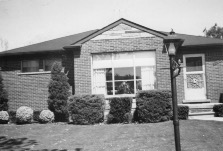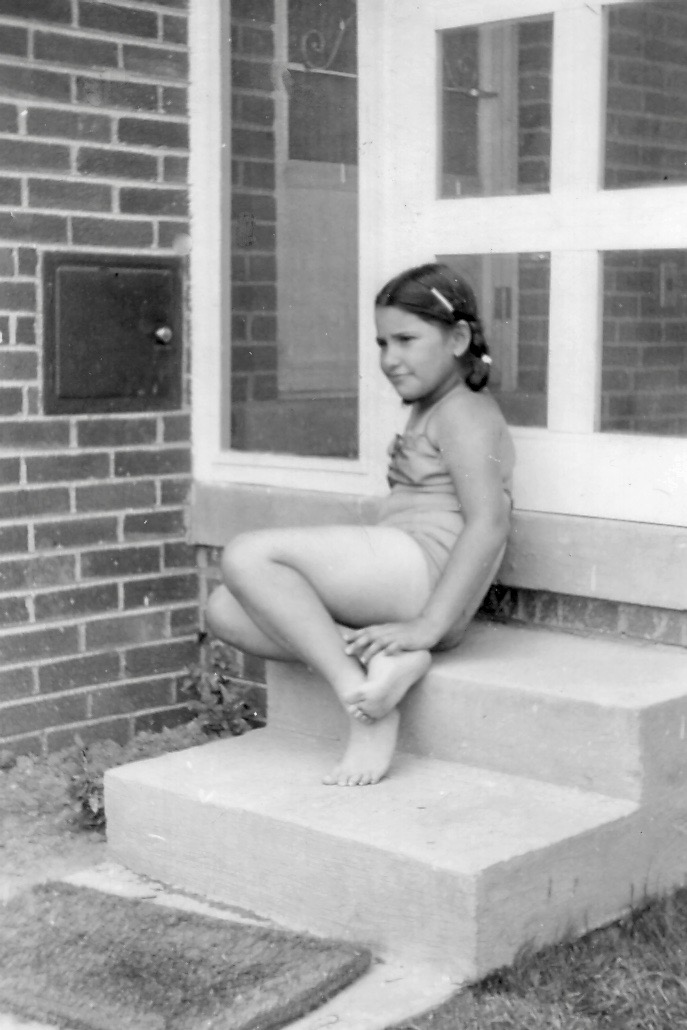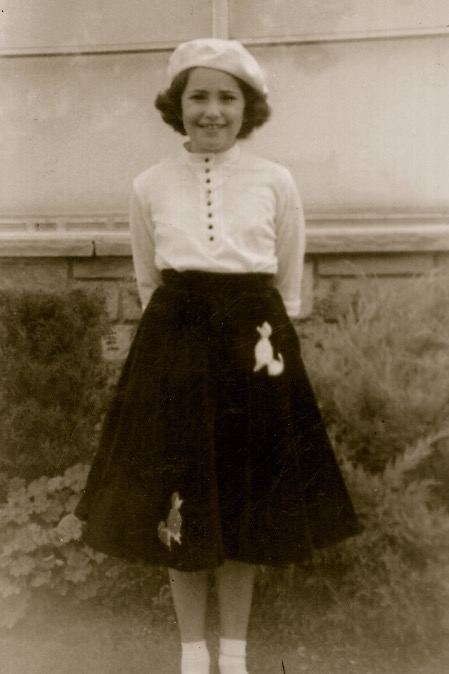
In 1952, my family made the trek from our old Detroit neighborhood to the brand-new suburb of Oak Park, Michigan. Malvina Reynolds’s song Little Boxes, made popular by Pete Seeger, best describes our new suburban home:
Suburbia and my mother were grooming me for my future occupation of Mom.
Little boxes all the same,
There’s a pink one and a green one
And a blue one and a yellow one
And they’re all made out of ticky tacky
And they all look just the same.
That November, we moved into our “starter” suburban home in which I lived until I left for college. At the time, mud and construction were all around the house. Our block was filled with boys the age of my brother Rick. He had eight instant friends and I had Susan, who was a couple of years older than I. Sadly, she was no substitute for my cousin Annette, whom I left behind in Detroit. Our house at 24030 Jerome looked so much like all of the others on the block that I went to the wrong house walking home from my first day of school.
Oak Park, the first suburb built outside of Detroit, consisted of small, ranch-style homes. Stimulated by the GI Bill, which aided veterans in buying new housing, highways that improved commuting, and planned developments that were all the rage in the fifties, Oak Park from 1950 to 1960 was named “America’s Fastest Growing City.” Its population increased sevenfold, from 5,000 to more than 36,000. This explains my meandering educational path growing up. I was shifted from building to building as the school system tried to keep up with the rapid influx of kids whose families were fleeing Detroit.
There were some special features that came with our suburban abode. For one, we had a milk delivery box by the back door that was just big enough for my baby brother to crawl through to open the door for us if we were locked out. No latch key kids back then, although I have no idea why my mother wasn’t home to open the door. I had my own room at the front of the house, just off the “living room-dining L.” My brothers shared a room meant to be a den, with no closet and doors on each end to pass from the back hallway to the kitchen. We all shared a bathroom. These houses were not air-conditioned. No dishwasher either. As the daughter, it was my job to dry the dishes every night.
I was also expected to help my mother with housekeeping. I didn’t mind ironing simple things like handkerchiefs and remember my mother madly ironing clothes while watching the McCarthy hearings in 1954. I knew he was a bad guy, but she never bothered to explain why. I also dusted according to her three-times-a-week schedule, but never understood the concept, as nothing was ever dirty.
Initially, I went to Francis Scott Key School, which was a few blocks away. All of the kids came home for lunch every day to eat in front of the television with Soupy Sales, White Fang and Black Tooth. I’m pretty sure we had a full hour, not the twenty minutes allotted to kids these days.
I vividly remember my third-grade teacher, Miss Cartwright, because she was so frightening. Miss Cartwright and her paddle confirmed all of my worst fears about school. Yes, in suburban Detroit in the fifties, corporal punishment was fine with parents. Most of the paddling recipients were boys. Johnny McCormick, who tended to talk out of turn and disobey her, was paddled every morning at the start of class to remind him to behave. I don’t think I ever raised my hand to answer a question that whole year. I was quiet and kept a low profile lest she paddle me as well. In Miss Cartwright’s class, we read nonfiction passages by going around the room and taking turns reading aloud. For someone so worried about making a mistake, this exercise was pure torture. I would try to calculate which paragraph would be mine so I could practice it in my head ahead of time, barely paying attention to the content of the lesson.
I don’t remember much about fourth grade except that I was sent to a different school due to overcrowding. I think that was also the year we attended school in split shifts, so my brother Rick went in the morning and I went in the afternoon. It wasn’t until fifth grade that I felt at all comfortable in school, mostly due to having a great teacher, Martin Hollander. I may have been back at Key School at that point, as they were building new elementary schools to accommodate all of the baby boom kids flooding the suburb. Mr. Hollander said we could run the class as a democracy and vote on what we wanted to learn. I have a vivid memory of the day he took our democracy away due to bad behavior and how crushed we were. I also remember him placing me in charge of the class when he left to do something, and my dismay when my classmates became loud and rowdy and refused to acknowledge my authority.
I guess I was a pretty immature fifth grader by today’s standards. When I had an emergency appendectomy that year, all I wanted was a Tiny Tears doll. After spending a week in the hospital, I came home to give my doll bottles of water which came out as “real tears” and pee. So fun to change her diaper. Suburbia and my mother were grooming me for my future occupation of Mom.
I invite you to read my book Terribly Strange and Wonderfully Real and join my Facebook community.
Boomer. Educator. Advocate. Eclectic topics: grandkids, special needs, values, aging, loss, & whatever. Author: Terribly Strange and Wonderfully Real.





Love this, Laurie! So familiar.
And that’s why we are such good friends, my dear!
Any baby boomer girl will identify with this story, Laurie. Never had a poodle skirt (love the photo), but the little box house we lived in was similar to yours. It had just been built in 1952 and we moved in the next year when I was an infant, so that’s all I remember. I was too young to watch the McCarthy hearings, but the whole protocol with school was very similar to yours.
The amazing thing, Marian, was that parents (or at least mine) never complained about the school transfers and patchwork educational sysem. I guess they were so happy to be out of the city that they accepted this as progress.
Great story, Laurie, and the pictures are amazing. Love that poodle skirt! And the beret! You were très chic! I didn’t live in suburbia, so no personal experience with a “little boxes”-type subdivision, but we did have a built-in milk box on the back porch of our 1920s house. Also no air-conditioning or dishwasher until my parents added both in the ’60s. Thanks for your memories.
Suzy, my parents contended we didn’t need AC (translation, couldn’t afford) until after I left the nest. We had a huge fan somewhere but I remember driving around on hot nights with all of the car windows rolled down to cool off. Those milk boxes and home delivered milk in glass bottles weren’t such a bad thing!
Fortunately, Laurie two of my sisters are just one and two years older than I. Yup. Poodle skirts (there’s an iconic photo of these two with the two daughters of one of my dad’s colleagues, all dressed in the fashion; it never ceases to embarrass them all to this day, for some reason). And Tiny Tears dolls (two, count ’em, two). Yep.
Ok, Tom, I had two younger brothers. So while you had to suffer through poodle skirts and Tiny Tears dolls, I endured toy army soldiers, cap guns, cowboy outfits, and the Lone Ranger. I think you wrote a funny piece about some of those items. Here’s to a less sexist future for this generation of kids.
I’d say that there was any suffering involved whatsoever. Wasn’t Tiny Tears preceded by Betsy Wetsy? But yes, I heartily agree with the hope for a less sexist future.
Another great story filled with sensory memory triggers. Our milk box was big enough for anyone to crawl through and so it also served as a favorite hiding place.. It was dark and cool, with a tin floor and a scary latch my older brother would clamp closed if he found out we were were playing hide-and-seek without him. I remember a little paper fan with pictures of dairy products…we’d just fan out the ones we wanted in the evening and in the morning open the box and there was everything we wanted, like magic. We also had a Helms Bakery truck that came by in the afternoons and we could just hop on and the driver would pull out wide drawers that glided open on ball bearings…rows and rows of fresh donuts, some glistening, some powdered, some decorated with sprinkles. And of course my favorite, cake donuts with chocolate frosting. And was that one of those felt-like poodle skirts I so coveted but never had? .I did have full skirts under which I wore a frilly petticoat, which always showed below the hem of my skirt because no matter how many times I rolled it over, it slid down over my non-existent hips.
Thanks for sharing your memories, Barbara. Wish we had that bakery truck in my suburb. I remember those petticoats we wore under full skirts. Mine had a hoop at the bottom (like the underwire on bras) to keep it at maximum poofiness. Once, I sat on the edge of a stage at school and the whole thing popped up. Humiliating. So glad to have shed all of these fashion constraints along with girdles, garter belts, and (more recently) panty hose. Men have no idea.
Laurie. your powers of recall and description are amazing!
And yes I had a poodle skirt too!
I’ve been trying to write memoir-stories for my grandkids who can’t imagine life before technology. Don’t you wish we had saved those skirts?
Yep, we should have saved those poodle skirts, and mine BTWwas grey with pink poodles!
I’d bet there are thousands on eBay!